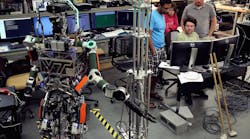Rethink Robotics, the manufacturer of the Baxter collaborative robot, announced on Nov. 3 that its new Robot Positioning System will allow the Baxter to manage and adapt to ever-changing, real-world environments.
The software upgrade helps users easily re-deploy the robot after common plant-floor variations occur, such as tables being bumped, fixtures being moved, and more.
The technology enables Baxter to switch between tasks without retraining by using environmental markers, called Landmarks, in conjunction with its existing, embedded vision system. The robot is now able to recognize the original locations of the markers, and, when those locations change slightly, can mark the new locations and adjust its movements accordingly.
"Manufacturing robots have always been caged, not only to protect the workers around them from harm, but also to protect their precisely configured environments from being disrupted by those same workers," said Scott Eckert, CEO at Rethink Robotics. "With Baxter, we brought the manufacturing robot out of its cage by making it safe enough to work next to people; and now, we've made it safe for the robot to work effectively in real-world conditions as well, by allowing it to adapt to everyday variations that people naturally produce."
Users can now define Baxter's environment with up to 20 Landmarks, saving time, manpower and resources when it comes to switching the applications Baxter is working on. One of the first customers to utilize the new technology, Praxis Packaging Solutions meets the diverse packaging demands for a wide variety of customers on a 24x7 basis. One of the defining characteristics of the Praxis production lines is rapid reconfiguration. Baxter provides flexible automated labor to meet those demands.
"We need our people and our automation to effectively work in a semi-structured, and sometimes variable, manufacturing environment. Rethink's Baxter robot, particularly with the new Robot Positioning System, provides a solution that can finally adjust to the changing conditions of our work cells," said Chris Hager, Information Technology Manager at the Michigan-headquartered Praxis Packaging Solutions.











